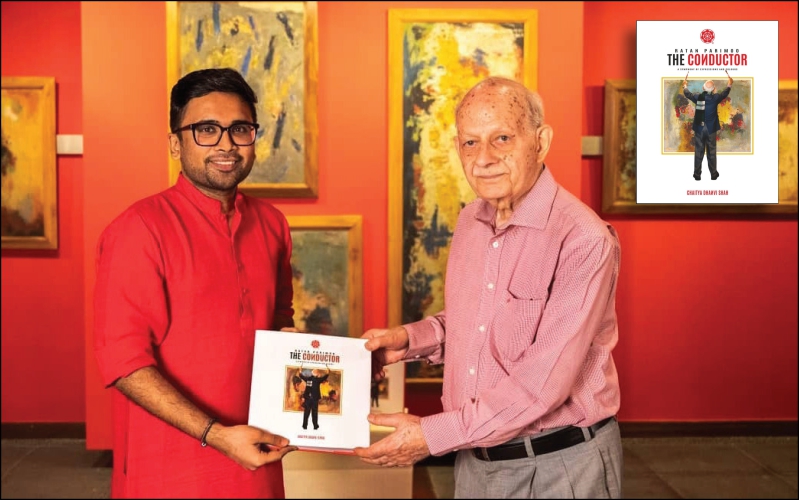
Chaitya Shah Publishes ‘The Conductor’ his book on Ratan Parimoo – Abstract Expressionist who created works in 1950s
29 April 2021: On March 19, 2021, DRS Arts Company® invited a select audience to a very special unveiling; the launch of a book on Ratan Parimoo’s Abstract Expressionist works created in the 1950s titled ‘The Conductor’ written by the company’s Curator and Managing Director, Chaitya Dhanvi Shah. The two-day event, held at Shapath I, SG Road, Ahmedabad, showcased museum-quality artworks and limited edition serigraph. ‘The Conductor’ is available in a Kindle version as well. Conceptualised with an aim to create art awareness and education, it provides a very rare opportunity to see such 60 years old works at any place apart from the museum. Read on for insights into the book and its genesis by Chaitya Dhanvi Shah.
What were the decision drivers that led to this book ?
The main objective of this book is to try and connect society with the artist and build that bridge between art and non-art lovers. ‘The Conductor’ gives me a chance to introduce people of our country and elsewhere, to explain what art is or how it can be perceived ? What is abstract art and abstract expressionism is all about? It is not only a part of art education but also a kind of reintroducing to our generation and the future ones of what the previous generation of Indian modern painters did and talk about their guts, glory, style, and intention.
I believe, In India, we need more such art books that educate the audience mainly the students, art lovers who want to start collecting art and the society at large.
What were the complexities involved in writing about such a legendary painter and his work ?
I have tried to explain what abstract expressionism is and how Parimoo conducts his works being a conductor of the symphony of expression and colours. To express, colours play a vital role. So we have a dedicated chapter on colour field where I talk about colours and culture, their effect on paintings and conductor’s colours. I am sure this book will connect with everyone who wants to understand art and artists, who want to explore Indian art and are proud of it.
I believe that each art work is a snapshot of a larger story. Every piece of art is nothing but a fossil left behind from a much larger story.
How did you start out in this field and what was the evolution process ?
I made my debut glamorously entrepreneurial at the raw age of 20 by single-handedly curating an art show exhibiting the works of master artists and contemporary artists of India at the Jehangir Art Gallery, Mumbai in 2007. That marked me as one of the youngest curators of the country. However, today, after spending so many years in the business, I still feel exactly what I used to feel at the age of 18 – the motto of my being into business now and forever will be to ‘create’ – create value for collectors, create opportunity for artists, create content for the society, create art that lasts forever and create satisfaction for myself.
I am ambitious and passionate about everything creative (especially the process than the end result) – that supports the ‘art ecosystem.’ To create something – Curator + creator = CURAT (E) OR is all I thrive for. I personally don’t feel money can ever provide me the satisfaction I feel by creating anything. I get a buzz out of sharing art knowledge by shifting mental pictures and giving people new tools for interpreting art. I fancy experimenting and writing about the works of several artists and in the process photographing and getting detailed interviews out of the artists.
Is your interest limited to India and Indian artists or are your horizons broader ?
I believe there is a lot of undiscovered art, waiting to be unexplored. And thus, though my base is Ahmedabad, I travel frequently across the globe to explore art. I love travelling to cities with the artists I work with, to document the artists’ thoughts and interpret his art in forms of photographs and books. I get a thrill out of researching on ancient forms of art, be it Jainism or Greek form of art. I love to combine diverse fields with art: art and theatre, art and performance, art and design, art and science, art and fashion, so on and so forth.
I want to stop people isolating ‘art’ from the rest of the things in the world. My weekly blogs and podcasts on art thus appeal for a sense of human awareness and spiritual consciousness related to art. The most significant thing for me to look in a work of art is quality. I love the entire process – of being immersed in the hard work of every artist I work with, of appreciating their skills, passion and perseverance while my mind works on curating the few art works I choose out of his collection.
How would you describe your approach towards the process ?
Make, find and sell masterpiece art! Don’t ever lose your focus in the process. That’s always been my motto. Understanding our culture and roots, knowing your own history as well as others’ history is important – it does not mean that you are dwelling in the past glories, but it makes you feel connected to what you have been and inspires you to take it forward – making you more progressive since you are aware of your identity. Art opens everything up to such a bigger spectrum of people. And this is why I personally believe art is powerful and change the society. With the same goal I have held a range of charity shows with our artists and associates: for cancer patients and deaf/blind children, for public grievances, and even for promoting Indian heritage.
What were the factors that influenced your choice of topic for the book ?
Ratan Parimoo was not just a painter in the 1950s, he was a bold, carefree and true painter. An artist committed to his art and painted with conviction. Courageous enough to explore his new style, Parimoo created his own path as an artist while India was searching for its identity post-independence. Going through the history of what is now termed as Indian Modern Art (which was Indian contemporary art back then); I would consider Parimoo as one of the pioneers of Abstract Expressionism in India. He understood and painted pure abstraction.
As a curator, checking the signature and date of the work has become akin to second nature, but this time I was taken aback. On seeing his work with such vivacious colours on a sixty-year-old canvas, I was compelled to reconfirm the year out of sheer disbelief. For a moment I had to question myself as to when was the last time I saw Indian abstract expressionist work from the late 1950s ? Even though I knew these are old works of art, I was genuinely baffled and awestruck.
Why did you decide to define Parimoo as a conductor ?
A conductor is a person who keeps all the musicians in the orchestra and different instruments together, on track. Looking at this series made me visualize him as a conductor and his use of colours and brush strokes as components of his symphony. He is the person who manages the emotions, colours, brush strokes, space, forms and overall composition. However, the conductor does more than that. Just like a musician, Parimoo has composed his ideas, thoughts, emotions and feelings through the arrangement of forms, colours, textures, material and brush strokes.
www.drsartscompany.com






